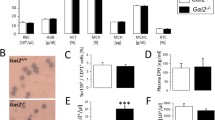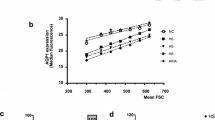Abstract
Gardos channel, the erythrocyte Ca2+-activated K+ channel (KCa3.1), is considered a major regulator of red blood cell (RBC) volume by mediating efflux of potassium and thus cell dehydration and shrinkage. However, the functional importance of KCa3.1 in RBC in vivo is incompletely understood. Here, we used KCa3.1−/−-mice to investigate the consequences of KCa3.1 deficiency for RBC indices, functions, and sequestration. RBCs of KCa3.1−/−-mice of all ages were mildly macrocytic but their biconcave appearance being preserved. RBC number, total hemoglobin, and hematocrit were unchanged in the adult KCa3.1−/−-mice and increased in the premature KCa3.1−/−-mice. Filterability, Ca2+-dependent volume decrease and osmotic tolerance of RBCs lacking KCa3.1 were noticeably reduced when compared to RBC of wild-type littermates. Deformability to increasing shear stress was unchanged. Strikingly, KCa3.1−/−-mice developed progressive splenomegaly which was considerable (∼200% of controls) in the >6-month-old mice and was paralleled by increased iron deposition in the aged mice presumably as a consequence of enhanced RBC sequestration. Daily injections of the KCa3.1-blocker TRAM-34 (120 mg/kg) also produced mild splenomegaly in wild-type mice. We conclude that genetic deficit of erythroid KCa3.1 causes mild RBC macrocytosis, presumably leading to reduced filterability, and impairs volume regulation. These RBC defects result in mild but progressive splenomegaly.






Similar content being viewed by others
References
Akel A, Wagner CA, Kovacikova J, Kasinathan RS, Kiedaisch V, Koka S, Alper SL, Bernhardt I, Wieder T, Huber SM, Lang F (2007) Enhanced suicidal death of erythrocytes from gene-targeted mice lacking the Cl−/HCO(3)(−) exchanger AE1. Am J Physiol Cell Physiol 292:C1759–C1767
Ataga KI, Smith WR, De Castro LM, Swerdlow P, Saunthararajah Y, Castro O, Vichinsky E, Kutlar A, Orringer EP, Rigdon GC, Stocker JW (2008) Efficacy and safety of the Gardos channel blocker, senicapoc (ICA-17043), in patients with sickle cell anemia. Blood 111:3991–3997
Begenisich T, Nakamoto T, Ovitt CE, Nehrke K, Brugnara C, Alper SL, Melvin JE (2004) Physiological roles of the intermediate conductance, Ca2+-activated potassium channel Kcnn4. J Biol Chem 279:47681–47687
Bertles JF (1957) Sodium transport across the surface membrane of red blood cells in hereditary spherocytosis. J Clin Invest 36:816–824
Boas FE, Forman L, Beutler E (1998) Phosphatidylserine exposure and red cell viability in red cell aging and in hemolytic anemia. Proc Natl Acad Sci USA 95:3077–3081
Browning JA, Ellory JC, Gibson JS (2006) Pathophysiology of red cell volume. Contrib Nephrol 152:241–268
Brugnara C (1997) Erythrocyte membrane transport physiology. Curr Opin Hematol 4:122–127
Brugnara C (2003) Sickle cell disease: from membrane pathophysiology to novel therapies for prevention of erythrocyte dehydration. J Pediatr Hematol Oncol 25:927–933
Brugnara C, de Franceschi L, Alper SL (1993) Inhibition of Ca2+-dependent K+ transport and cell dehydration in sickle erythrocytes by clotrimazole and other imidazole derivatives. J Clin Invest 92:520–526
Canham PB (1969) Difference in geometry of young and old human erythrocytes explained by a filtering mechanism. Circ Res 25:39–45
Clark MR, Shohet SB (1980) The effect of abnormal hemoglobins on the membrane regulation of cell hydration. Tex Rep Biol Med 40:417–429
De Franceschi L, Rivera A, Fleming MD, Honczarenko M, Peters LL, Gascard P, Mohandas N, Brugnara C (2005) Evidence for a protective role of the Gardos channel against hemolysis in murine spherocytosis. Blood 106:1454–1459
Dekkers DW, Comfurius P, Bevers EM, Zwaal RF (2002) Comparison between Ca2+-induced scrambling of various fluorescently labelled lipid analogues in red blood cells. Biochem J 362:741–747
Engstrom KG, Lofvenberg E (1998) Treatment of myeloproliferative disorders with hydroxyurea: effects on red blood cell geometry and deformability. Blood 91:3986–3991
Gardos G (1958) The function of calcium in the potassium permeability of human erythrocytes. Biochim Biophys Acta 30:653–654
Hoffman JF, Joiner W, Nehrke K, Potapova O, Foye K, Wickrema A (2003) The hSK4 (KCNN4) isoform is the Ca2+-activated K+ channel (Gardos channel) in human red blood cells. Proc Natl Acad Sci USA 100:7366–7371
Huber SM, Duranton C, Henke G, Van De Sand C, Heussler V, Shumilina E, Sandu CD, Tanneur V, Brand V, Kasinathan RS, Lang KS, Kremsner PG, Hubner CA, Rust MB, Dedek K, Jentsch TJ, Lang F (2004) Plasmodium induces swelling-activated ClC-2 anion channels in the host erythrocyte. J Biol Chem 279:41444–41452
Ishii TM, Silvia C, Hirschberg B, Bond CT, Adelman JP, Maylie J (1997) A human intermediate conductance calcium-activated potassium channel. Proc Natl Acad Sci USA 94:11651–11656
Jacob HS, Jandl JH (1964) Increased cell membrane permeability in the pathogenesis of hereditary spherocytosis. J Clin Invest 43:1704–1720
Kohler R, Wulff H, Eichler I, Kneifel M, Neumann D, Knorr A, Grgic I, Kampfe D, Si H, Wibawa J, Real R, Borner K, Brakemeier S, Orzechowski HD, Reusch HP, Paul M, Chandy KG, Hoyer J (2003) Blockade of the intermediate-conductance calcium-activated potassium channel as a new therapeutic strategy for restenosis. Circulation 108:1119–1125
Lang F, Lang KS, Wieder T, Myssina S, Birka C, Lang PA, Kaiser S, Kempe D, Duranton C, Huber SM (2003) Cation channels, cell volume and the death of an erythrocyte. Pflugers Arch 447:121–125
Lang PA, Kaiser S, Myssina S, Wieder T, Lang F, Huber SM (2003) Role of Ca2+-activated K+ channels in human erythrocyte apoptosis. Am J Physiol Cell Physiol 285:C1553–C1560
Lange T, Jungmann P, Haberle J, Falk S, Duebbers A, Bruns R, Ebner A, Hinterdorfer P, Oberleithner H, Schillers H (2006) Reduced number of CFTR molecules in erythrocyte plasma membrane of cystic fibrosis patients. Mol Membr Biol 23:317–323
Murphy E, Berkowitz LR, Orringer E, Levy L, Gabel SA, London RE (1987) Cytosolic free calcium levels in sickle red blood cells. Blood 69:1469–1474
Norton JM (1990) The effect of macrocytosis on rat erythrocyte deformability during recovery from phenylhydrazine-induced anemia. Biorheology 27:21–37
Ohnishi ST, Katagi H, Katagi C (1989) Inhibition of the in vitro formation of dense cells and of irreversibly sickled cells by charybdotoxin, a specific inhibitor of calcium-activated potassium efflux. Biochim Biophys Acta 1010:199–203
Olivieri O, De Franceschi L, Capellini MD, Girelli D, Corrocher R, Brugnara C (1994) Oxidative damage and erythrocyte membrane transport abnormalities in thalassemias. Blood 84:315–320
Pellegrino CM, Rybicki AC, Musto S, Nagel RL, Schwartz RS (1998) Molecular identification and expression of erythroid K:Cl cotransporter in human and mouse erythroleukemic cells. Blood Cells Mol Dis 24:31–40
Peters LL, Shivdasani RA, Liu SC, Hanspal M, John KM, Gonzalez JM, Brugnara C, Gwynn B, Mohandas N, Alper SL, Orkin SH, Lux SE (1996) Anion exchanger 1 (band 3) is required to prevent erythrocyte membrane surface loss but not to form the membrane skeleton. Cell 86:917–927
Poschl JM, Leray C, Ruef P, Cazenave JP, Linderkamp O (2003) Endotoxin binding to erythrocyte membrane and erythrocyte deformability in human sepsis and in vitro. Crit Care Med 31:924–928
Rhoda MD, Apovo M, Beuzard Y, Giraud F (1990) Ca2+ permeability in deoxygenated sickle cells. Blood 75:2453–2458
Rust MB, Alper SL, Rudhard Y, Shmukler BE, Vicente R, Brugnara C, Trudel M, Jentsch TJ, Hubner CA (2007) Disruption of erythroid K–Cl cotransporters alters erythrocyte volume and partially rescues erythrocyte dehydration in SAD mice. J Clin Invest 117:1708–1717
Si H, Heyken WT, Wolfle SE, Tysiac M, Schubert R, Grgic I, Vilianovich L, Giebing G, Maier T, Gross V, Bader M, de Wit C, Hoyer J, Kohler R (2006) Impaired endothelium-derived hyperpolarizing factor-mediated dilations and increased blood pressure in mice deficient of the intermediate-conductance Ca2+-activated K+ channel. Circ Res 99:537–544
Sprague RS, Ellsworth ML, Stephenson AH, Kleinhenz ME, Lonigro AJ (1998) Deformation-induced ATP release from red blood cells requires CFTR activity. Am J Physiol 275:H1726–H1732
Stocker JW, De Franceschi L, McNaughton-Smith GA, Corrocher R, Beuzard Y, Brugnara C (2003) ICA-17043, a novel Gardos channel blocker, prevents sickled red blood cell dehydration in vitro and in vivo in SAD mice. Blood 101:2412–2418
Tiffert T, Daw N, Etzion Z, Bookchin RM, Lew VL (2007) Age decline in the activity of the Ca2+-sensitive K+ channel of human red blood cells. J Gen Physiol 129:429–436
Toyama K, Wulff H, Chandy KG, Azam P, Raman G, Saito T, Fujiwara Y, Mattson DL, Das S, Melvin JE, Pratt PF, Hatoum OA, Gutterman DD, Harder DR, Miura H (2008) The intermediate-conductance calcium-activated potassium channel KCa3.1 contributes to atherogenesis in mice and humans. J Clin Invest 118:3025–3037
Unver N, Freyschmidt-Paul P, Horster S, Wenck H, Stab F, Blatt T, Elsasser HP (2006) Alterations in the epidermal–dermal melanin axis and factor XIIIa melanophages in senile lentigo and ageing skin. Br J Dermatol 155:119–128
Verloo P, Kocken CH, Van der Wel A, Tilly BC, Hogema BM, Sinaasappel M, Thomas AW, De Jonge HR (2004) Plasmodium falciparum-activated chloride channels are defective in erythrocytes from cystic fibrosis patients. J Biol Chem 279:10316–10322
Woon LA, Holland JW, Kable EP, Roufogalis BD (1999) Ca2+ sensitivity of phospholipid scrambling in human red cell ghosts. Cell Calcium 25:313–320
Wulff H, Miller MJ, Hansel W, Grissmer S, Cahalan MD, Chandy KG (2000) Design of a potent and selective inhibitor of the intermediate-conductance Ca2+-activated K+ channel, IKCa1: a potential immunosuppressant. Proc Natl Acad Sci USA 97:8151–8156
Wulff H, Zhorov BS (2008) K+ channel modulators for the treatment of neurological disorders and autoimmune diseases. Chem Rev 108:1744–1773
Zhang R, Alper SL, Thorens B, Verkman AS (1991) Evidence from oocyte expression that the erythrocyte water channel is distinct from band 3 and the glucose transporter. J Clin Invest 88:1553–1558
Zhou Q, Zhao J, Wiedmer T, Sims PJ (2002) Normal hemostasis but defective hematopoietic response to growth factors in mice deficient in phospholipid scramblase 1. Blood 99:4030–4038
Acknowledgments
This work was supported by the DFG (project-A11-SFB593; J.H., RK.), by the DFG graduate school GRK767 (H.P.E.), and by the German Kidney Foundation and German Society of Hypertension (I.G.). We wish to thank Mrs. Brigitte Agricola for the excellent technical assistance.
Author information
Authors and Affiliations
Corresponding author
Additional information
Ivica Grgic and Brajesh P. Kaistha contributed equally to this study.
Electronic supplementary material
Below is the link to the electronic supplementary material.
ESM Fig. 1
(PDF 258 kb)
ESM Fig. 2
(PDF 31 kb)
ESM Fig. 3
(PDF 23 kb)
ESM Tab. 1 and 2
(DOC 50 kb)
ESM Tab. 5
(DOC 39 kb)
Rights and permissions
About this article
Cite this article
Grgic, I., Kaistha, B.P., Paschen, S. et al. Disruption of the Gardos channel (KCa3.1) in mice causes subtle erythrocyte macrocytosis and progressive splenomegaly. Pflugers Arch - Eur J Physiol 458, 291–302 (2009). https://doi.org/10.1007/s00424-008-0619-x
Received:
Accepted:
Published:
Issue Date:
DOI: https://doi.org/10.1007/s00424-008-0619-x




